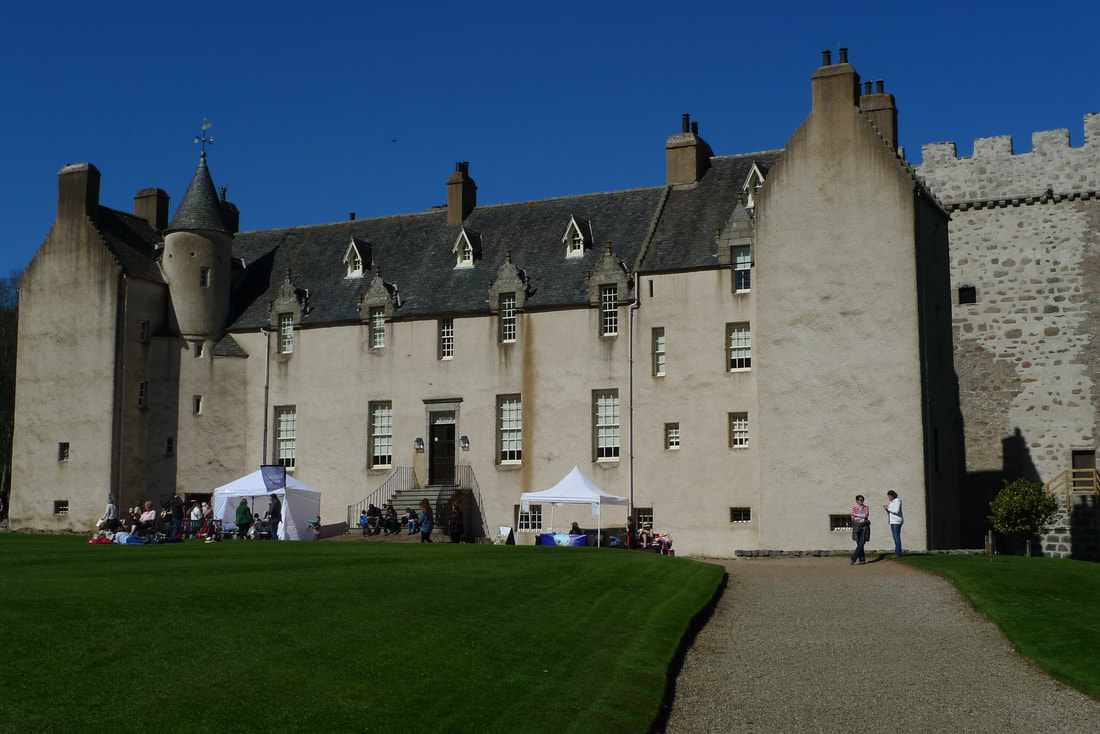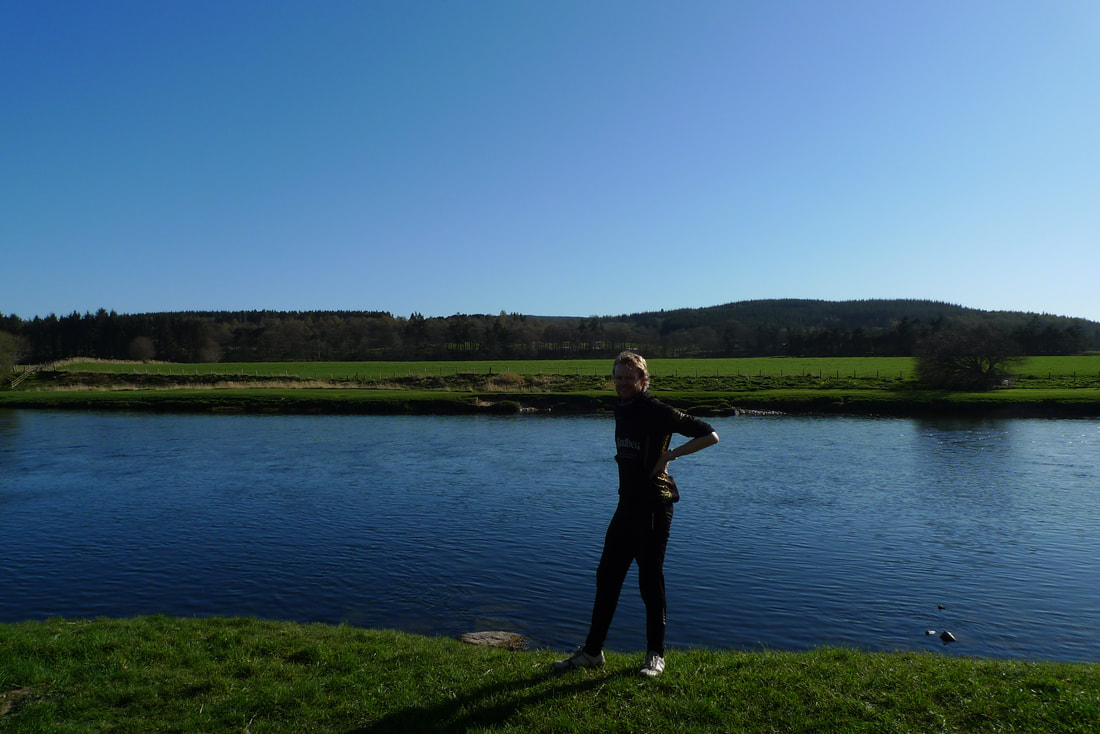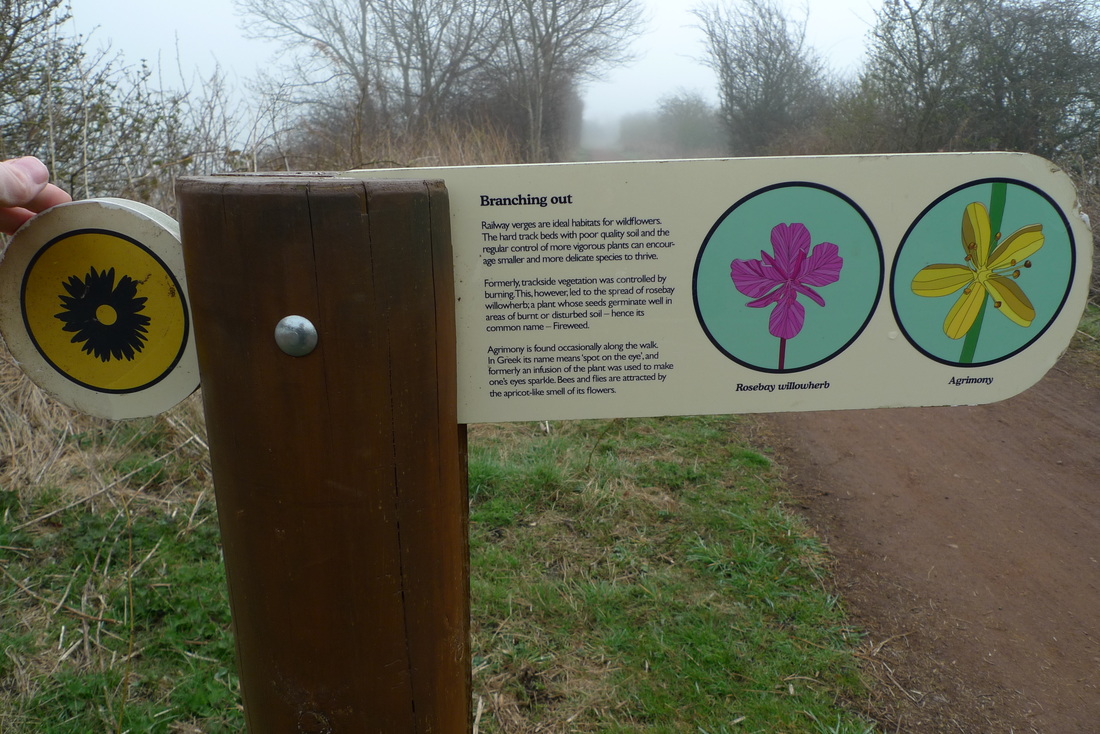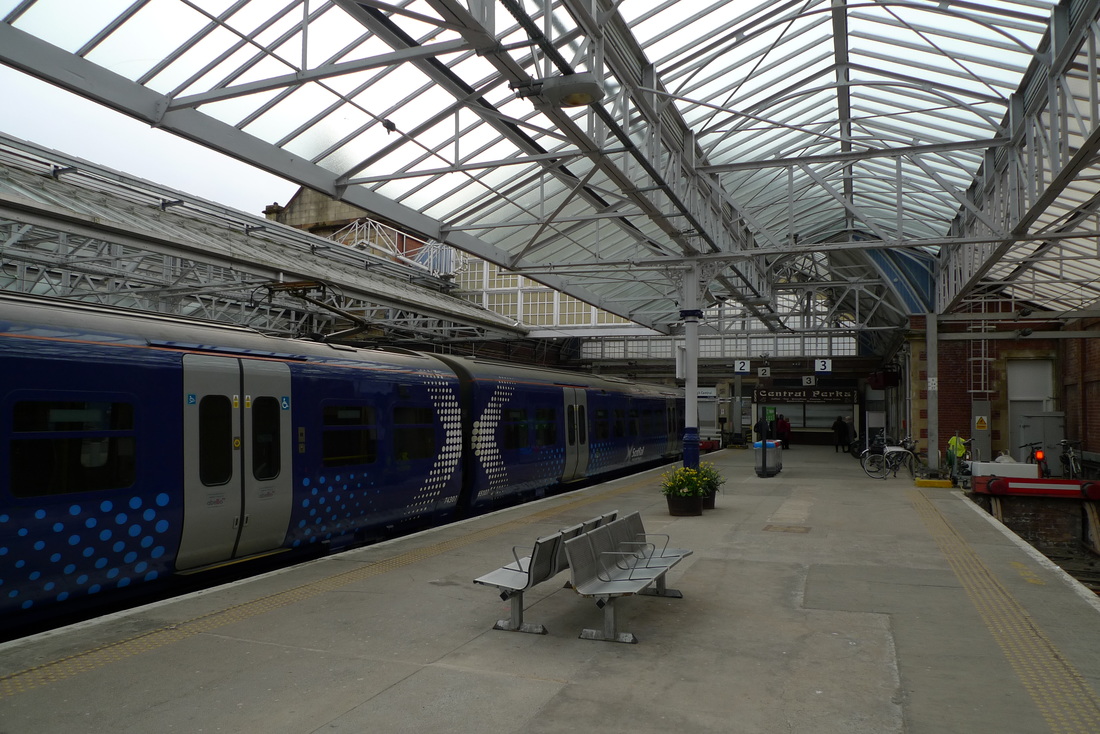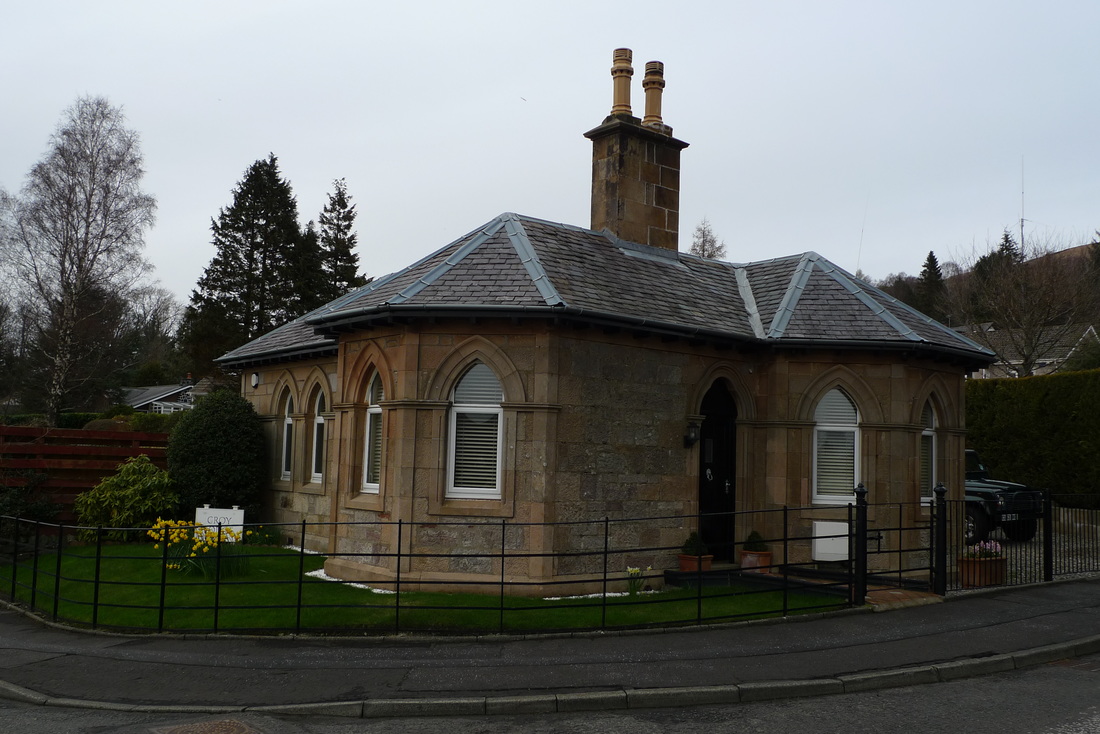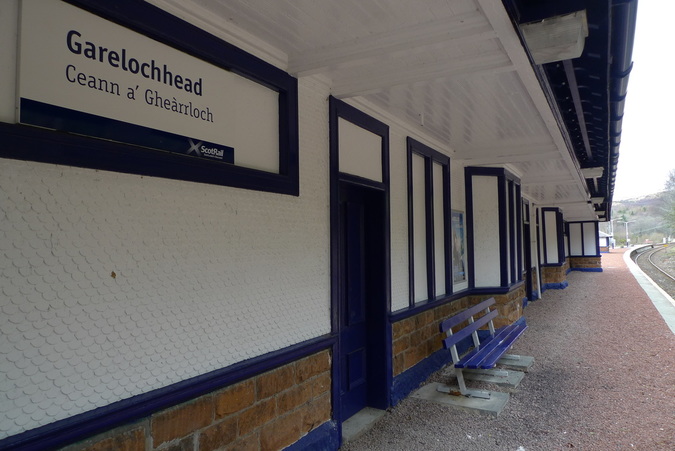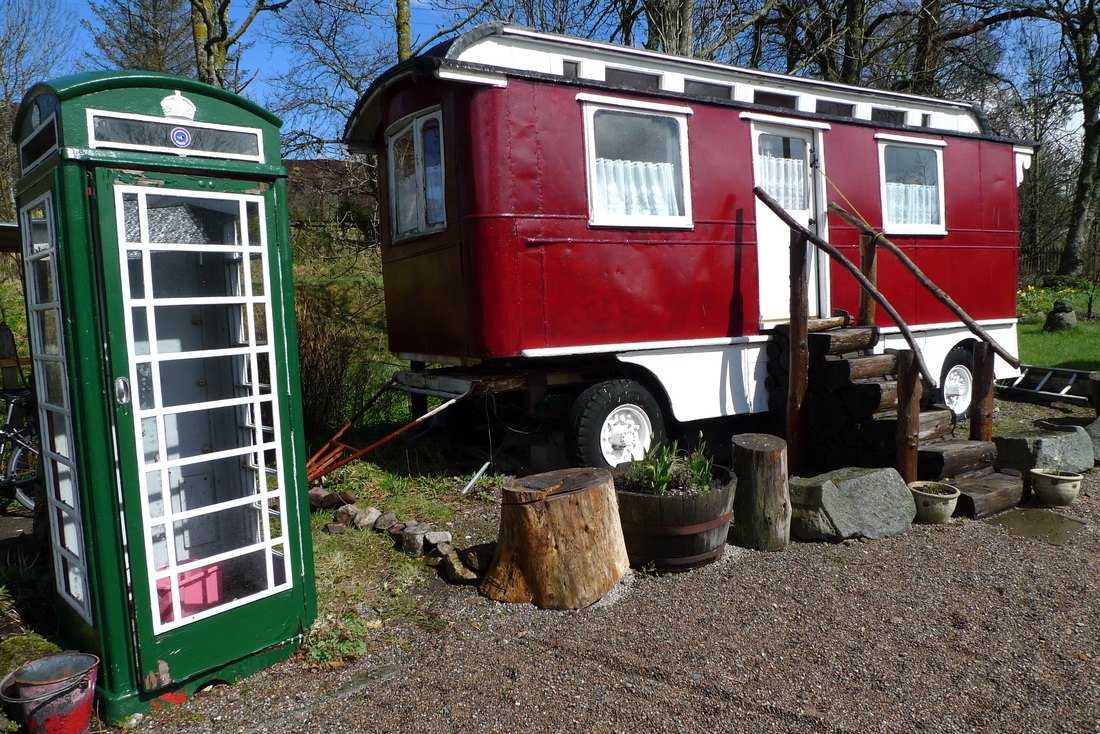|
The Deeside Way is a 41 mile cycle path, mostly traffic-free, from Aberdeen to Ballater. It follows the line of the Deeside Railway, once famously used by The Royal Family to travel to Balmoral Castle. Here are 10 things you can see and do along the way:
1. Old Station Buildings
Most of the Deeside Line's stations survive today. Information boards tell the story of each building. This is a photo of Murtle Station which has a canopy held up with decorative iron struts. Passengers once got off here to visit the Deeside Hydropathic which offered a variety of treatments, including Turkish and Russian baths.
2. Allan Park
A secret garden just waiting to be discovered, Allan Park, is a short distance from Cults Station. It is hidden away in a valley with a set of steep stairs taking you down to a world of ponds, trees and birdsong. This is the perfect place to relax with a picnic lunch.
3. Drum Castle
Drum Castle was occupied for 653 years by a single family, the Irvines, until the death of the 24th Laird in 1976. Inside there are the expected castle essentials, such as a library full of beautifully bound books, a Gallery hung with family portraits and four poster bed. There is even a cabinet containing the 11th century hair of Malcolm, King of Scots. The extensive grounds offer woodland walks and rose gardens.
4. Deeside Railway
The Deeside Railway has restored a mile of track at Milton of Crathes and created an authentic experience of what rail travel was like back in the day. Travel in the 1950s Battery Multiple Unit where the front seats look into the driver's cab and give a view of the tracks. Grab a coffee in the buffet carriages and admire the restored timber station with its fireplace and ticking clock.
5. Milton Art Gallery
The work of local artists is displayed inside restored farm buildings. Take home a painting, sculpture or jewelry inspired by the Aberdeenshire landscapes and nature. The Art Gallery is adjacent to the Deeside Railway. and Crathes Castle is a short walk from here.
6. Crathes Castle
The sculpted yew trees are the most incredible feature of the gardens of Crathes Castle. They date back to the early 1700s and have been continuously trimmed by generations of gardeners to keep them in the egg and cup shape that you see today. The painted ceilings inside the castle are jaw dropping. The room of the Nine Nobles features bearded military heroes, like Alexander the Great, Hector of Troy and Julius Caesar.
7. Grave Robber Watchtower, Banchory
Cycling into Banchory you will spot a curious round tower; it was a watchtower installed to deter grave robbers in the nineteenth century. It has a bell and the sight of this sent a shiver down my spine as I imagined it being rung by a panicking watchman on spotting body snatchers. The sound would awaken the foggy town and the people would be in no doubt about what was going on.
8. Cambus O'May Suspension Bridge
This charming footbridge, built in 1905, crosses the River Dee. It has lattice girders, a cute turnstile entrance and is painted gleaming white. On the other side there are woodland walks to enjoy. The bridge is 3 miles east of Ballater.
Note that the Cambus O'May suspension bridge is currently not accessible after storm damage (March 2018).
9. River Dee
The 5th longest river in Scotland and famous for its salmon fishing the Dee is a constant companion for cyclists on the Deeside Way. For large sections you are riding alongside it, so make a stop and take a seat by its banks for a bit of relaxation.
10. Royal Station, Ballater
Board a replica of a Royal Train carriage and take a peek at the Royal toilet in the waiting room- it has a blue and white porcelain bowl painted with fruits and flowers. There is a tea room that perfectly captures the nostalgia of nineteenth century railway refreshment rooms.
Read about my cycling trip on the Deeside Way: Part One: Aberdeen to Banchory Part Two: Banchory to Ballater
2 Comments
East Linton. You would be hard pressed to find a prettier village. Colourful flower beds, a row of characterful buildings and a fountain with golden figures. When you are cycling on Route 76 it is worth stopping to have a look around and then head to the nearby Smeaton Nursery Gardens and Tearoom for a spot of lunch next to the bird feeders.
The previous blog covers the cycle route from Haddington to Hailes Castle. From the castle continue along the narrow road for just under 2 miles and you will enter East Linton over a bridge crossing the River Tyne.
The village has a variety of buildings, which makes it an interesting and attractive place to walk around.
In this photo I like the small white house with the round window in its gable, sandwiched between the grander white building and the stone cottage:
There are some of the characteristic East Lothian cottages with their red roof tiles. In this photo I like how the window to the right of the door is higher up than the window to the left of the door:
The centrepiece of the village is the cast-iron fountain with figures of four boys pouring urns. There is a decorative lamp stand on the top of the fountain.
There are a couple of places to eat in the village, but I tried the Smeaton Nursery Gardens and Tearoom less than a mile away, down a long driveway (marked on the map below).
I had pea and watercress soup, a coffee cake and a cappuccino. It was excellent food, but what I loved the best about this tearoom was being able to watch the bird feeders out of the window. A blue tit arrived at one of the feeders just as I sat down. It was pecking at the seeds and I noticed that more seed seemed to end up on the ground than in his beak!
I tried to take a photograph of the birds, but each time I positioned my camera they flew off, so these photos are not brilliant.
The birds waited in a nearby hedge and then flew over to the feeders once the coast was clear. Each time that I made a movement to take a photo the birds flew away back to the hedge. They waited there until they felt safe enough to come back to the feeder. Again, when I moved they flew back to the hedge. I decided to sit still and enjoy watching them than trying to get a perfect photo. East Linton is due to have its train station reopened. This is written into the contract of the current operator of the Scotrail franchise, but no dates has yet been set. It does mean that it will be much easier to reach this village and access the surrounding area by bicycle. Where to next? Preston Mill is in East Linton and well worth a visit. Read my blog about Preston Mill. How to get to East Linton East Linton is just under 6 miles from the nearest train station at Drem. For a circular route that starts at Lingniddry station and ends at Drem follow these steps
For an easy day out take the 18 minute train journey from Edinburgh to Longniddry. From there you can cycle the 4.5 mile traffic-free path to Haddington. This is a disused railway with information panels about the line's history and the wildlife that lives here.
At Longniddry station the start of the path is marked with a large wooden sign announcing the distance to Haddington. There is also a warning to be on the look out for thieves. I would not worry, you are quite safe on this peaceful path.
There are information posts at regular intervals along the route. They are in the style of railway signals and you operate them by pushing them down to raise the "signal". This reveals a panel with information about wildlife or the line's history. It is a clever design that pays homage to the railway heritage of the path.
This branch line was closed in 1968, but there have been calls to reopen it on the basis that the population of Haddington is increasing and many people commute to Edinburgh.
There is plenty of evidence of the railway, mainly in the form of these stone bridges:
This photograph provides a good view of the colossal stones used in the construction of these bridges:
There is something that looks like a pond alongside the path. This had been a tank for the steam engines to load up on water. Nowadays it provides a home for frogs, toads and water beetles:
I enjoyed reading about events in the railway's past on the information panels. There had been a regular train that carried manure from Edinburgh police horses to be used as fertiliser on East Lothian farms. In 1937 a train went straight through the buffers at Haddington station. It was thought that frost on the rails caused the accident.
This is a popular path, so you will likely come across walkers, joggers and other cyclists.
Once in Haddington cycle up to Station Yard industrial estate where you can find the surviving station building on a piece of platform. I used this cycle route to reach the radio station, East Coast FM, located at Station Yard. I was invited to speak on air about my blog and cycling in Scotland.
Haddington is an attractive town with neat streets and interesting buildings, so it is worth having a look around.
There is a sculpture of two goats fighting. They are up on their hind legs and head butting each other. The goat is the emblem of Haddington and it is on the town’s coat-of-arms.
Next: cycle to Hailes Castle
My next blog covers the route from Haddington to Hailes Castle. Visit a whisky distillery This railway path features in the cycle route to Glenckinchie distillery. Read my feature about cycling to the distillery. Visit a motor museum, Concorde and the birthplace of Scotland's flag Drem, the next station along from Longniddry, provides easy cycling access to these attractions. Read my blog about where you can cycle to from Drem
The 9 mile route between Helensburgh and Garelochhead features a segregated cycle path, the smell of the sea, lunch at a marina, the call of oystercatchers and a nuclear submarine base.
Regonal Cycle Route 42 links Helensburgh and Garelochead in Argyll. The route is largely along a cycle path on the main road, so not the most enjoyable ride, but there are nice views of the sea and some interesting things to see along the way. Begin at Helensburgh Central train station
Helensburgh Central is another fine survivor from the golden era of Scotland's railways. It has a long glass canopy, decorative ironwork and wood paneling in the ticket office. It is nicely decorated with pots of colourful flowers.
You may wish to linger in Helensburgh. The seafront location makes it a pleasant place for a stroll and an ice cream. You can also visit Hill House, designed by Charles Rennie Macintosh the famous Scottish architect. The inventor of the television, John Logie Baird (no relation), was born in Helensburgh.
The cycle route begins on the A814. Cycle westwards through the quieter streets of the town to avoid the busy road for as long as possible and to reach the start of the shared pavement and cycle path. This can be found opposite Cumberland Avenue where you will spot the blue Route 42 cycle signage. All you have to do now is follow these signs until you reach Garelochead.
It soon becomes clear that the strategy of this route is to keep bikes away from the main road as much as possible, so you will find some interesting bits of cycle infrastructure, like this section:
Helensburgh and the surrounding area is a wealthy part of Scotland, so you will notice some impressive houses. This lodge house is a more modest example that sits alongside the cycle route. I like the Gothic-style windows.
"Scottish Tapas" at Rhu
About two miles into the route you will reach the village of Rhu which sits on a curve of the loch and has a parish church tower dominating the horizon. As I passed through Rhu I could smell the salty air mixed with smoke from log burning fires in cosy cottages. At a football pitch a group of lads were sat on the grass, resting and chatting after their game.
I went for the carrot and coriander soup, served with a warm roll. It was just perfect on a slightly chilly day.
I liked the nautical decor of the cafe- red and white sails hanging from the ceiling and rope tied to the curtains to hold them in place. There are only 6 tables in the cafe and most of the clientele were ordering takeaway whilst having a bit of banter with the couple running the place. I heard the man joke about one customer, "Don't serve this guy! He used to come here all the time for fish n' chips. Now he doesn't. There's no excuse. We do airmail you know." There is a lot of yachting activity taking place here. There is a chandlery shop next door, boats were being repaired in the yard and I watched tractors dragging around boats on trailers. The route passes the Faslane Peace Camp. The residents of this collection of colourful caravans are protesting against the nuclear weapons that are kept at the Faslane Naval Base. The camp has been here since 1982 and there have been frequent protests through the years, including blockades of the base.
The route then proceeds alongside the immense fence and rolls of barbed wire that protect the perimeter of the base. Signs warn of CCTV and patrolling armed guards. At one point I negotiated a van parked on the cycle path and men were up on ladders carrying out repairs to the fence.
The route passed an entrance to the base where vehicles were being stopped at a checkpoint by armed guards. There was something unsettling to see such a sight in Scotland, particularly in the middle of the countryside. It is rare to see guns in Scotland and this is probably one of the few, if not the only place, in the country where you are going to see armed men. It was not pleasant to pass so close to them on my bicycle and I found myself desperately avoiding eye contact.
Garelochhead is a small village with not very much to see apart from the views of the loch. It is a peaceful place, a place where the call of the oystercatcher is the loudest noise. Prior to World War II it had been popular for people from Glasgow to travel here by steamer for holidays, but it has since declined as a tourist destination. Garelochhead has a train station, part of the famous West Highland Line, so you could get a train back to Glasgow instead of cycling back to Helensburgh. Be aware that trains on this line are less frequent and you must have an advanced reservation to take your bike on this train.
Combine this with a visit to Dumbarton Castle
The train to Helensburgh stops at Dumbarton East station from where you can easily reach Dumbarton Castle. The castle is a magical, fairytale grotto experience. Read my blog post about Dumbarton Castle You don't need to stick to marked cycle routes. You can create your very own cycle routes. All you need is a road atlas and your imagination. Dedicated cycle routes give you the confidence that you are going the right way and that you will be safe; directed away from busy traffic. The National Cycle Network (NCN), with its clearly marked and signed routes, is the ideal way to explore Scotland by bike, but it does not cover all corners of the country, so I like to plan my own routes. I love thumbing through my road atlas to come up with new possibilities for bicycle routes. Many of the journeys on my website have been created this way. Here are my top tips for creating your own cycle routes: 1. Look for a train station I use the train to access cycle routes, so I always look at train stations on my road atlas. Some stations are located in magnificently rural areas which give immediate access to roads with little traffic. What type of roads lead away from the station? Are they minor roads, with low-traffic volume? If the answer is yes, then you may have discovered a perfect cycle route. It might be that your dream route starts some distance away from a station, but you could still cycle from the station to the start of the route. For the ultimate isolated station with great cycling try Altnabreac 2. Avoid big roads This goes without saying. You cannot cycle along the M74, although in 2014 members of the Sri Lanka Commonwealth Games team did it for their training, but they were stopped by police. On my atlas I avoid roads that are blue or red in colour. The roads I want are the ones with no number, the white roads, because I know there will be hardly any traffic. If I can find a route with ony this type of road I will be very happy. B-roads and A-roads can also be suitable for cycling, but some can be busy with traffic, so it pays to do a bit more resarch using Google Street View. 3. Use Google maps Street View If it looks like you might need to use major roads for your route it is worth finding out if the roads are likely to be busy. Google Street View lets you get a good look at the roads. Move along the road within Street View for a few minutes to see how many vehicles are on the road. The chances are that if it was busy at the time the Google car filmed the road it will also be busy when you cycle on it. Street View will also allow you to see how wide the road is. A wider road, even if busy with traffic, can still be good for cycling as it means plenty of room for vehicles to overtake you. You might even discover a cycle path that you didn't know existed! Several times this has happened to me when using Google Street View. I have seen a cycle lane along a busy road that I did not know about and this helped me to decide to include the road on the route. 4. Ask locals Once you arrive at your destination try asking locals about the traffic conditions, particularly on the major roads, to get intel on their suitability for cycling. There have been several times where I have ruled out a particular road, believing it to be too busy for cycling, but on arriving into the area I have found out from a local that the road is good for cycling. 5. Build your routes around visitor attractions Add something interesting to your cycle route. Visitor attractions are marked on road atlases and if you can incorporate these into a cycle route it will add some history, culture and cake! Remember that many of these places have tea rooms, so they also provide a nice respite on a cycle journey. 6. A place to stay If your route involves big distances there is a good chance that you will need to stay the night somewhere. Factor this in when designing routes, so that the end of each day is in a location with accommodation options. Or if you find somewhere unique to stay the night it might be worth designing the route around this. For example, the old railway carriages that are converted to rooms at Rogart station are a special experience so my cycle route incorporates them.
|
Categories
All
Archives
July 2024
|




